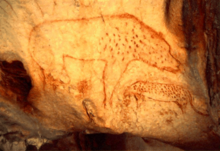洞鬣狗
| 洞鬣狗 化石时期:中至晚更新世
| |
|---|---|

| |
史前
| |
| 科学分类 | |
| 界: | 动物界 Animalia |
| 门: | 脊索动物门 Chordata |
| 纲: | 哺乳纲 Mammalia |
| 目: | 食肉目 Carnivora |
| 科: | 鬣狗科 Hyaenidae |
| 属: | 斑鬣狗属 Crocuta |
| 种: | 斑鬣狗 C. crocuta
|
| 亚种: | 洞鬣狗 C. c. spelaea
|
| 三名法 | |
| Crocuta crocuta spelaea | |
洞鬣狗(学名:Crocuta crocuta spelaea)是斑鬣狗已滅絕的一個亞種[1],分佈於伊比利半島至西伯利亞東部[2]。雖然洞鬣狗最初因前後肢的不同而被描述成獨立的物種,但基因分析顯示洞鬣狗與斑鬣狗並沒有DNA的明顯分別。[3]除了洞鬣狗的化石外,一些石洞壁畫亦有發現洞鬣狗。洞鬣狗於約2萬至1萬年前的冰河時期末滅絕,原因仍然未知,但多半認為是氣候變遷以及與其他掠食者競爭造成[4][5]。
描述
[编辑]洞鬣狗的體型遠大於現存於非洲的斑鬣狗,體重可達 102公斤(225磅)[6],掌骨與跖骨也較短而粗壯,肱骨與股骨則較長[7],這是為了生活於和斑鬣狗不同的環境所做出的適應[8]。與斑鬣狗同樣為兩性異形,雌性鬣狗體型大於雄性[9]。由一些石洞壁畫可知,洞鬣狗和斑鬣狗一樣具有斑點[10]。
對於洞鬣狗的社交習性只知很少。一般接受牠們都是生活在洞穴中。現時未有顯示牠們是成群生活或是獨自生活的,但更新世環境似乎不可能有成群生活的動物。[3]
食性
[编辑]洞鬣狗像現今的鬣狗般會在巢穴積存獵物的骨頭及角,供日後食用或玩耍,但這些骨頭並不清楚是屬於腐屍的或是被獵殺的動物。就波西米亞岩洞內遺骸的研究顯示,普氏野馬明顯是牠們的獵物,約佔16-51%。洞鬣狗最大的獵物是披毛犀,在很多洞鬣狗的巢穴中都有發現牠們的骨頭及頭顱骨。在一些區域,披毛犀佔其獵物的25-30%。馴鹿亦是另一個重要的食物來源,約佔7-15%。長角野牛及馬鹿分別佔1-6%及3%,其他的亦包括了愛爾蘭麋鹿、臆羚及野山羊則只有少於3%。[11]
一般相信洞鬣狗是將洞熊骨骼拆解及破壞的元兇。這麼大型的腐肉是洞鬣狗的重要食物,尤其是在冬季當食物短缺時。穴獅、狼及貂熊的遺骸亦於洞鬣狗的巢穴發現。另外有證據顯示洞鬣狗有時會同類相食的。[11]
與人科的關係
[编辑]
有證據指洞鬣狗會偷取尼安德特人的獵物,而牠們亦會為洞穴而競爭,並會取代對方擁有該洞穴。在洞鬣狗的骨頭積存中亦發現有大量的人科骨頭,包括尼安德特人的。現今人類亦會與洞鬣狗並存,估計他們之間亦有相似的關係。
參考文獻
[编辑]- ^ Rohland, N, Pollack, JL, Nagel, D, Beauval, C, Airvaux J, Paabo, S & Hofreiter, M, 2005. The population history of extant and extinct hyenas. Molecular Biology and Evolution,. 22: 2435-2443.
- ^ Summerill, Lynette; Gnawed Bones tell Tales (页面存档备份,存于互联网档案馆), Summer 2003, ASU Research
- ^ 3.0 3.1 Comparison of Crocuta crocutacrocuta and Crocuta crocutaspelaea through computertomography (PDF). Dockner, Martin. Department of Paleontology, University of Vienna. [2008-01-20]. (原始内容 (PDF)存档于2011-05-22).
- ^ C. Stiner, Mary (2004) Comparative ecology and taphonomy of spotted hyenas, humans, and wolves in Pleistocene Italy (页面存档备份,存于互联网档案馆), Revue de Paléobiologie, Genève. (December 2004) 23 (2) : 771-785. ISSN 0253-6730
- ^ Varela, S., Lobo, J. M., Rodríguez, J. and Batra, P. (2010). Were the Late Pleistocene climatic changes responsible for the disappearance of the European spotted hyena populations? 互联网档案馆的存檔,存档日期2012-04-26. Quaternary Science Reviews, 29: 2027-2035.
- ^ Meloro, C., 2007. Plio-Pleistocene large carnivores from the Italian peninsula: functional morphology and macroecology (页面存档备份,存于互联网档案馆). Ph.D. Thesis, Univ. Naples Federico II.
- ^ Kurtén, Björn (1968). Pleistocene mammals of Europe. Weidenfeld and Nicolson. pp. 69-72.
- ^ Dockner, M., 2006. Comparison of Crocuta crocuta crocuta and Crocuta crocuta spelaea through computer tomography. Ph.D. Thesis, Univ. Vienna, Austria.
- ^ DIEDRICH, C.G. & ŽÁK, K. 2006. Prey deposits and den sites of the Upper Pleistocene hyena Crocuta crocuta spelaea (Goldfuss, 1823) in horizontal and vertical caves of the Bohemian Karst (Czech Republic) (页面存档备份,存于互联网档案馆). Bulletin of Geosciences 81(4), 237–276 (25 figures). Czech Geological Survey, Prague. ISSN 1214-1119.
- ^ Spassov N.; Stoytchev T. 2004. The presence of cave hyaena (Crocuta crocuta spelaea) in the Upper Palaeolithic rock art of Europe (页面存档备份,存于互联网档案馆). Historia naturalis bulgarica, 16: 159-166.
- ^ 11.0 11.1 Prey deposits and den sites of the Upper Pleistocene hyena Crocuta crocuta spelaea (Goldfuss, 1823)in horizontal and vertical caves of the Bohemian Karst (PDF). Cajusg. Diedrich & Karelzák. [2008-01-20].[永久失效連結]
